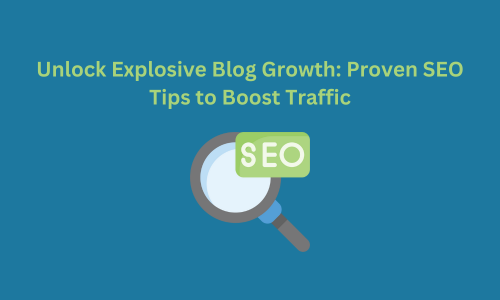

In today’s crowded online space, just having a blog isn’t enough. To stand out and reach your audience, mastering SEO (Search Engine Optimization) is essential. SEO helps your blog rank higher on search engines like Google, driving organic traffic and helping your content get noticed. But what are the best strategies to make this happen? In this guide, we’ll explore actionable SEO tactics to increase your blog’s visibility and grow your audience.
Master Keyword Research for Targeted Traffic
SEO success begins with keyword research. You need to understand what terms your potential readers are searching for and incorporate them naturally into your content. Use tools like Google Keyword Planner, SEMrush, or Ahrefs to find keywords with high search volume but low competition. Look for long-tail keywords (e.g., “how to start a food blog”) to help your content rank faster. By targeting the right keywords, you align your blog with your audience’s search intent, improving your chances of ranking higher in search results.
Optimize On-Page SEO for Maximum Impact
On-page SEO refers to optimizing individual blog posts and pages to enhance search visibility. Ensure your blog titles, meta descriptions, and headers contain your target keywords in a natural way. Also, make sure your blog is mobile-friendly—Google prioritizes mobile-first indexing, so a mobile-optimized blog can boost your rankings significantly. Additionally, ensure fast load times, as slow-loading pages can hurt both your rankings and user experience.
Produce Quality Content That Solves Problems
High-quality content is the backbone of any successful blog. Make sure your posts provide value to your readers by solving their problems or answering their questions. Engaging, informative, and relevant content not only keeps visitors on your site longer but also encourages them to return. The more valuable your content is, the more likely it will be shared, increasing your blog's authority and reach.
Focus on Readability and Structure
Longer, well-structured content tends to perform better in search results. Break up your text with subheadings (H2, H3), bullet points, and short paragraphs to make it easier to read. This not only improves user experience but also makes it easier for search engines to index your content, enhancing your SEO performance.
Use Visuals Wisely
Adding images, infographics, or videos to your blog posts improves user engagement. However, to optimize these elements for SEO, be sure to include Alt text that describes the image and contains relevant keywords. This also boosts accessibility and helps search engines index your content more effectively.
Boost Your Blog’s Speed
Site speed is a critical factor for both user experience and SEO rankings. If your blog takes too long to load, visitors are likely to leave, which negatively impacts your bounce rate. Use tools like Google PageSpeed Insights to identify and fix any issues. Compressing images, using a content delivery network (CDN), and optimizing your site’s code can make a big difference in performance.
Keep URLs Simple and Descriptive
A clean, easy-to-read URL structure is essential for both users and search engines. Include your primary keyword in the URL, keep it short, and avoid unnecessary numbers or characters. A user-friendly URL can improve click-through rates and make your content easier to share.
Leverage Sitemaps and Robots.txt
An XML sitemap helps search engines crawl your site more efficiently. Make sure to submit your sitemap to Google Search Console to ensure all your blog posts are being indexed. Similarly, configure your robots.txt file to tell search engines which parts of your site should be crawled and indexed.
Lower Bounce Rate and Increase Dwell Time
Search engines like Google consider user engagement metrics like bounce rate and dwell time when ranking your blog. Encourage visitors to stay on your site longer by creating compelling content, using internal links to guide them to related posts, and adding clear calls to action (CTAs). The longer visitors stay, the more favourable your blog will appear to search engines.
Prioritize User-Friendly Design
A visually appealing, easy-to-navigate blog increases user engagement. A clean layout with a good balance of text, visuals, and white space improves readability and encourages visitors to explore more. Use tools like the Hemingway App or Grammarly to improve your writing style and readability.
Guest Blogging for Backlinks
One of the most effective ways to build high-quality backlinks is by guest blogging on authoritative sites in your niche. Backlinks from reputable sources signal to search engines that your blog is trustworthy and valuable, which boosts your rankings.
Network and Build Relationships
Building relationships with other bloggers, influencers, and websites can open doors for link-building opportunities. Interact with others in your niche, comment on their posts, and engage with them on social media. Networking can lead to natural backlink opportunities that will help your SEO.
Promote Your Content to Earn Links
Promote your blog posts across social media, forums, and through email outreach to make your content visible. The more people see your content, the higher the chance you’ll earn organic backlinks, improving your blog’s authority and search rankings.
Monitor Your Blog’s Performance
Use Google Analytics to track traffic, user behaviour, and conversion rates on your blog. This data helps you identify what’s working and what needs improvement. For example, if a particular post is driving traffic, consider creating more content around that topic.
Stay Ahead with Google Search Console
Google Search Console provides valuable insights into how your blog performs in search results. It shows which search queries are driving traffic, click-through rates, and any indexing issues. Regularly checking Search Console helps you identify problems and optimize your blog for better rankings.
Perform Regular SEO Audits
An SEO audit helps you identify and fix issues that may be holding your blog back. Regularly check for broken links, outdated content, and technical problems. Keeping your blog optimized ensures you stay competitive as SEO trends and algorithms change.
Adapt to Algorithm Changes
Google frequently updates its search algorithms, which can impact your blog’s rankings. Stay informed about these updates and adjust your SEO strategy accordingly. Following SEO news and joining online communities can help you stay ahead of the curve.
Use SEO Tools to Your Advantage
SEO tools like Yoast SEO (for WordPress) and Rank Math make optimizing your blog easier. They offer real-time suggestions for improving your posts and help automate many on-page SEO tasks. Leveraging these tools can save time and ensure your content is always optimized.
Boosting your blog’s visibility through SEO requires consistent effort and dedication. By following these proven strategies—targeting the right keywords, optimizing your content, and building backlinks—you’ll see significant improvements in your organic traffic. Remember, SEO is not a one-time fix, but an ongoing process. Stay patient, stay committed, and watch your blog’s visibility soar over time.
Start implementing these strategies today to see your blog rise in search rankings and attract a growing audience.
Disclaimer: This article is provided for informational purposes only. It is not offered or intended to be used as legal, tax, investment, financial, or other advice.
